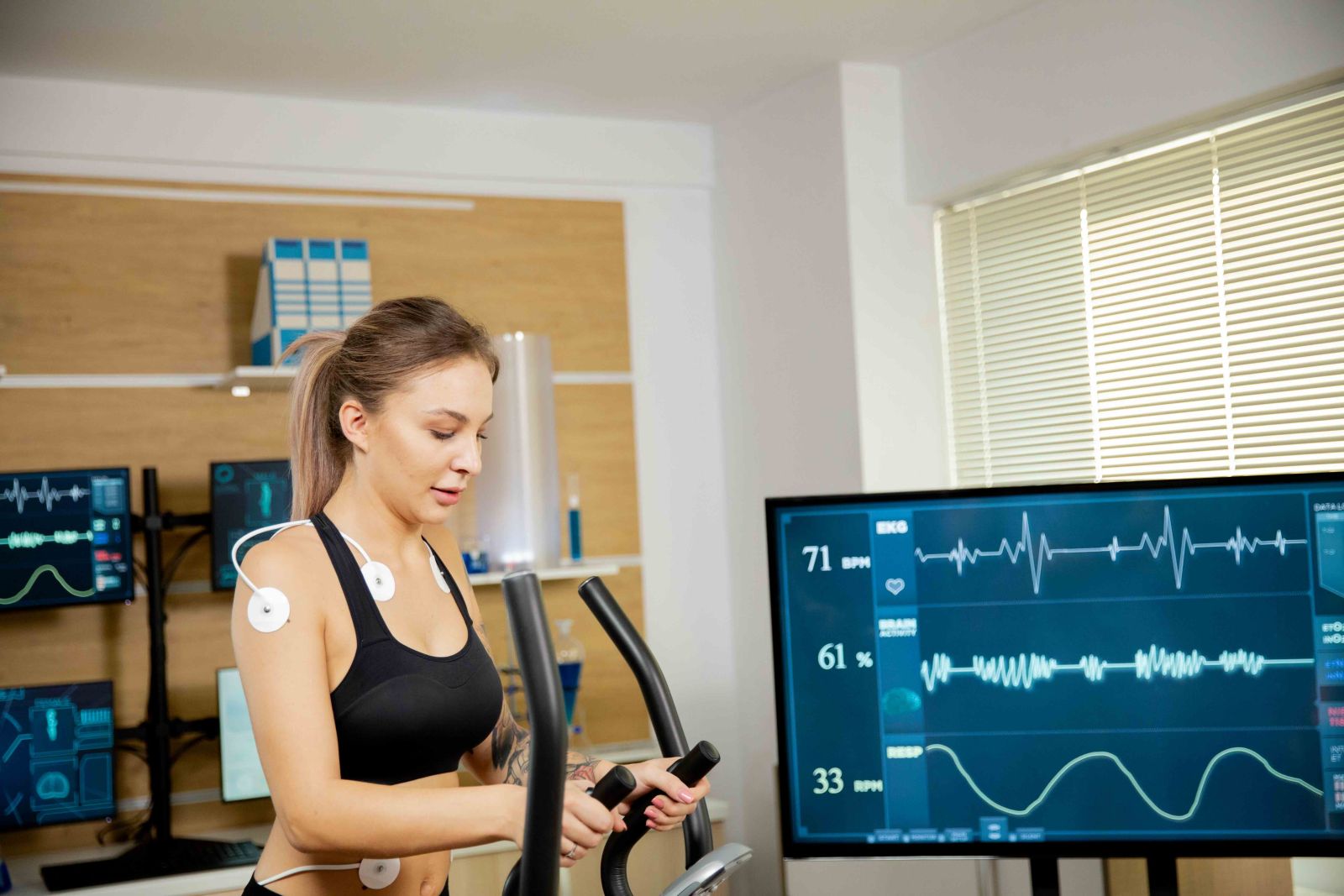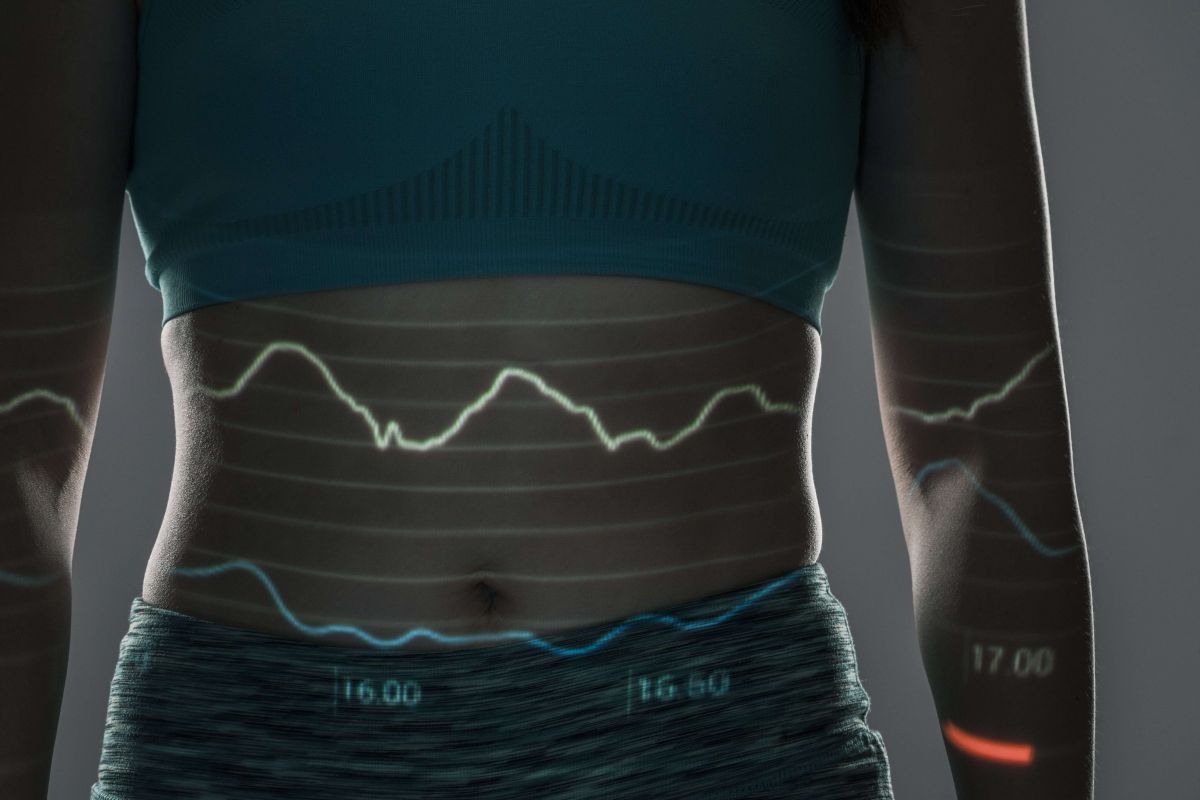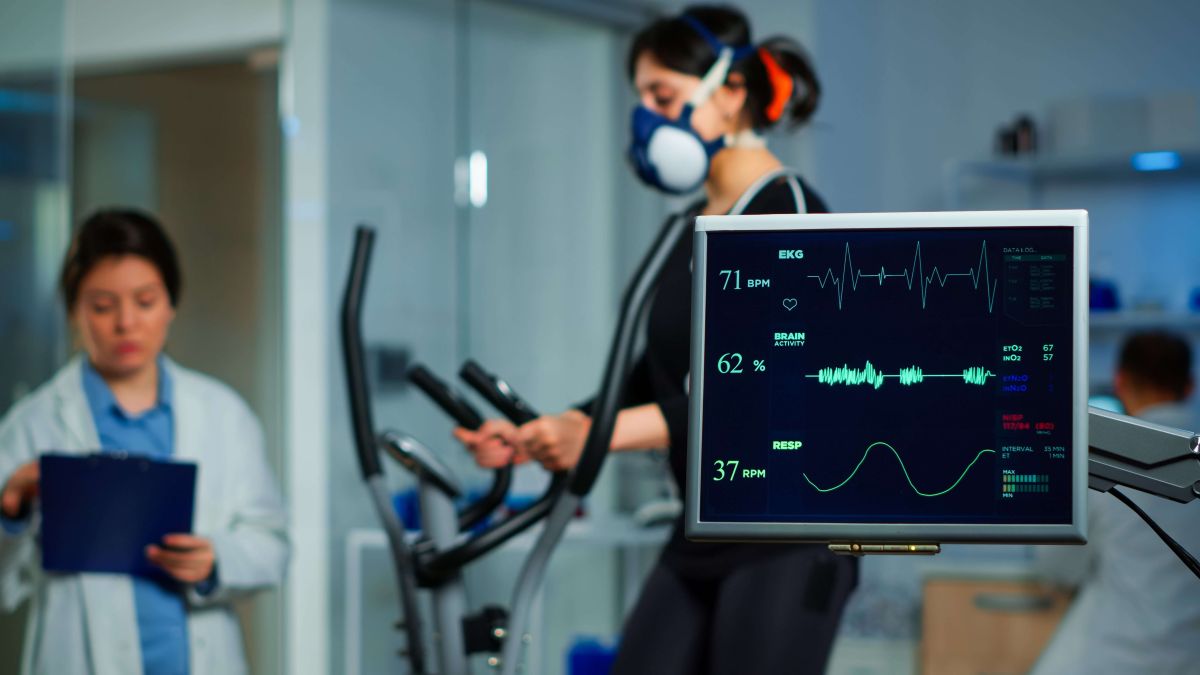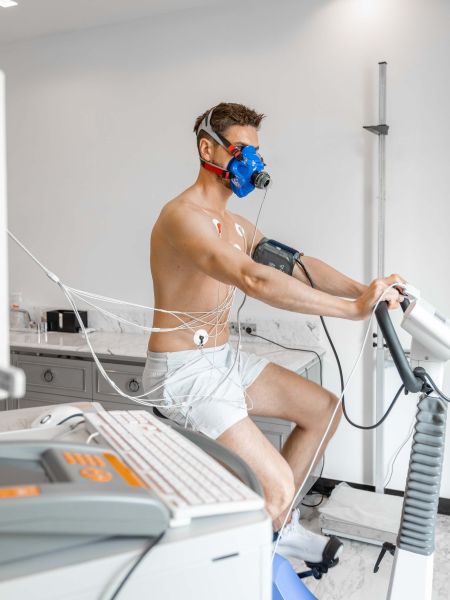Guide: heart rate zone ranges and optimizing your body composition

At BodyStack, we believe in the key principles of optimizing and lengthening healthspan to be:
Optimizing body composition by maintaining and building muscle mass and strength and minimizing visceral fat.
Increasing Cardiorespiratory health and fitness by way of increasing your VO2 max.
In order to make significant strides for both of these principles, there are many protocols that you need to follow surrounding nutrition, exercise, sleep, rest, stress management and the list goes on.
PROBLEM: Certain cardiovascular workouts can be counterproductive to muscle growth, recovery, and overall energy. Certain zones (like 3+4), run the risk of depleting the muscle tissue's ability to repair and grow.
To be a heavy "cardio" athlete doesn't necessarily have to come at the expense of building and maintaining lean mass.
SOLUTION: Know your zones… This sh*t can get complicated, but if you're able to accurately establish your RMR, VO2 Max, HR Max and Zone heartbeat ranges, you're on the right path.
Fortunately, modern technology and recent research is making the path easier for us each individually to define.
Establishing RMR and VO2 Max via testing:
Metabolic cardiorespiratory testing assesses two key physiological measures: Resting Metabolic Rate (RMR) and VO2 max. These tests are performed using specialized equipment, often referred to as a metabolic cart. One popular product at fitness or wellness clinics is the CardioCoach by KORR technologies, which cost around $13,000 USD.
Here's a breakdown of how each test works:
1. Resting Metabolic Rate (RMR) Testing
The Resting Metabolic Rate is the number of calories your body burns while at rest. It reflects the energy required to maintain essential bodily functions, such as breathing, blood circulation, and cellular activity.
How RMR Testing Works:
Preparation: The individual is required to fast for at least 8-12 hours before the test and should avoid strenuous physical activity. They are also asked to rest comfortably, avoiding movement during the test.
Breathing Device: The person breathes into a specialized mouthpiece or mask connected to the metabolic cart.
Gas Exchange Measurement: The cart measures oxygen consumption as you inhale (VO2) and carbon dioxide production (VCO2) as you exhale. These gas exchange rates help determine the body's energy expenditure.
Indirect Calorimetry: The method used in this test is called indirect calorimetry. It calculates the energy expenditure (in calories) based on the rate of oxygen consumption and carbon dioxide production.
RMR Calculation: The metabolic cart uses these gas exchange values to calculate the RMR in calories/day. This provides an estimate of how many calories your body needs to burn and function while at rest.
RMR indicates Fat vs Carbohydrate Calorie Burning
Outside of indicating total calories burned, RMR tests can provide an estimate of how much of your body burns carbohydrate calories vs. fat calories by analyzing your respiratory exchange ratio (RER). RER is measured during the test and reflects the ratio of carbon dioxide (CO2) produced to oxygen (O2) consumed. This ratio helps indicate whether your body is burning primarily carbohydrates or fats for energy.
How RMR Tests Estimate Fat vs. Carbohydrate Burn:
During an RMR test, you breathe into a mask or mouthpiece, and the machine measures your oxygen intake and carbon dioxide output while you're at rest.
From these gas measurements, the RER is calculated, which provides insight into the substrate utilization (the proportion of fats vs. carbohydrates your body is using as fuel).
Understanding Respiratory Exchange Ratio (RER):
RER = VCO₂ / VO₂
VCO₂: Volume of carbon dioxide produced.
VO₂: Volume of oxygen consumed.
The RER value ranges from 0.7 to 1.0:
RER = 0.7: Indicates 100% fat oxidation. This means your body is primarily burning fat for energy.
RER = 1.0: Indicates 100% carbohydrate oxidation. At this point, your body is burning mostly carbohydrates for energy.
RER between 0.7 and 1.0: A mix of fat and carbohydrate oxidation. For example, an RER of 0.85 suggests your body is burning roughly 50% fat and 50% carbohydrates, which is sometimes referred to as the "anaerobic threshold".
The anaerobic threshold is the point at which the body begins to metabolize sugar using anaerobic pathways, which are less efficient and cause lactic acid to build up. The anaerobic threshold is also known as the lactate threshold or aerobic to anaerobic transition point.
Key Points About Substrate Utilization:
Fat burning: Generally dominant at lower intensities or during rest, reflected by lower RER values (closer to 0.7).
Carbohydrate burning: Tends to dominate during higher-intensity activity or when energy needs increase, reflected by RER values closer to 1.0.
What an RMR Test Can Tell You:
Proportion of energy from fats and carbohydrates: Based on your RER, the RMR test can approximate the percentage of your energy that comes from fat vs. carbohydrates while you're at rest.
Metabolic efficiency: Some individuals may have a higher RER at rest, meaning they are burning more carbohydrates than fat. Others may be more "fat-adapted" and burn a higher percentage of fat even at rest.
Importance for Training and Nutrition:
Fat-burning vs. carb-burning efficiency: Understanding your RER can help you tailor your diet and training. For example, if you are burning more carbohydrates at rest, you might focus on improving fat oxidation through diet (e.g., lower carbohydrate intake) and aerobic training.
Fat Loss and endurance goals: If you're looking to optimize fat burning (especially for fat loss or endurance training), knowing the proportion of fat vs. carbohydrate burn can guide how you adjust your training intensity and diet routine.
RMR Limitations:
RMR tests reflect resting conditions, so the proportion of fat vs. carbohydrate burn can change dramatically with exercise or changes in diet. For example, during high-intensity workouts, the body relies more on carbohydrates, even if you burn more fat at rest.
In summary, an RMR test can approximate how much of your body's energy at rest comes from carbohydrates vs. fats, based on your RER. This information is useful for understanding your metabolic efficiency and can help guide training and dietary strategies.

2. VO2 Max Testing
VO2 max measures the maximum amount of oxygen the body can utilize during intense exercise. It's a key indicator of cardiovascular fitness and endurance.
How VO2 Max Testing Works:
Preparation: The individual is typically advised to avoid heavy exercise the day before the test and to wear comfortable athletic gear. Hydration and normal eating are usually encouraged.
Exercise Protocol: The test involves a graded exercise protocol on a treadmill or stationary bike. The intensity of the exercise gradually increases, typically every 1-3 minutes, until the individual reaches their maximal effort.
Breathing Device: As with RMR, the individual wears a mask or mouthpiece connected to the metabolic cart.
Gas Exchange Monitoring: The cart continuously measures oxygen consumption (VO2), carbon dioxide production (VCO2), and ventilation (VE).
Heart Rate Monitoring: Heart rate is tracked throughout the test to correlate with oxygen uptake.
VO2 Max Determination: As the exercise intensity increases, the oxygen uptake rises until it plateaus. The point at which oxygen consumption no longer increases, despite an increase in workload, is considered the VO2 max.
Result Interpretation: VO2 max is usually expressed in milliliters of oxygen consumed per minute per kilogram of body weight (mL/kg/min). It indicates the individual's aerobic capacity and fitness level. The lighter you are in terms of body weight, the more it works in your favor to have a higher VO2 max.
Equipment and Technology Used:
Metabolic Cart: The central piece of equipment that measures gas exchange (O2 and CO2) in real-time.
Treadmill/Bike: Used during VO2 max testing for graded exercise.
Mask/Mouthpiece: The subject breathes into a mask that is connected to the metabolic cart for accurate measurement of gases.
Key Differences:
RMR Test: Measures calorie burn at rest; performed in a resting state.
VO2 Max Test: Measures maximal oxygen consumption during exercise; involves physical activity at increasing intensities.
Both tests provide valuable data for assessing metabolic health, energy needs, and cardiovascular fitness.
Establishing your Zones from the VO2 Max Test
A VO2 max test helps determine your heart rate zones (zone 1 through zone 5) by correlating your heart rate with your oxygen consumption at various levels of exercise intensity. These zones represent different intensity levels that correspond to percentages of your VO2 max and maximal heart rate (HR max). By identifying your VO2 max and the heart rate you achieve at different stages of exercise, the test helps define your personal heart rate zones, which are critical for training in specific metabolic states.
How VO2 Max Testing Identifies Heart Rate Zones:
During a VO2 max test, your oxygen consumption (VO2) and heart rate (HR) are measured as exercise intensity increases. As the intensity rises, your heart rate increases, and your body shifts through different metabolic states that correspond to various heart rate zones. Here's a breakdown of how the test helps identify each zone:
1. Zone 1 (Active Recovery)
Heart Rate: 50-60% of your HR max
Oxygen Consumption: Low (beginning of the test)
Metabolism: Primarily uses fats for fuel; minimal lactate production.
Test Observation: During the early stages of the VO2 max test, your heart rate is low, and oxygen consumption remains relatively stable. This is when you are in the zone 1 range, often used for recovery or warm-up.
2. Zone 2 (Aerobic Zone)
Heart Rate: approximately 60-70% of your HR max
For the average 40-year-old adult male or female:
HR max ≈ 180 bpm
Zone 2 (60-70%):
Lower end: 108bpm
Upper end: 126bpm
Oxygen Consumption: Moderate; body continues to burn fat but starts using more carbohydrates.
Metabolism: Still predominantly aerobic, but the contribution from carbohydrate metabolism increases.
Test Observation: As exercise intensity increases, you'll hit a stage where your oxygen consumption begins to rise steadily. This is zone 2, where your body is operating efficiently and primarily utilizing oxygen to burn fat and some carbohydrates. This zone is often targeted for endurance training. If you can speak in full sentences without gasping for air, you're likely within Zone 2.
3. Zone 3 (Tempo Zone)
Heart Rate: 70-80% of your HR max
Oxygen Consumption: Higher than in zones 1 and 2; both fat and carbohydrates are being used as fuel.
Metabolism: Aerobic with some anaerobic contribution, and lactate begins to accumulate but can still be cleared by the body.
Test Observation: At this point in the test, your breathing becomes more labored, and oxygen consumption continues to rise. Zone 3 is often used for tempo training, where you can sustain a challenging pace for an extended period.
4. Zone 4 (Lactate Threshold)
Heart Rate: 80-90% of your HR max, here's some directional figures.
Oxygen Consumption: Approaching VO2 max; carbohydrate metabolism becomes dominant.
Metabolism: Anaerobic processes start to become more prominent, and lactate builds up faster than the body can clear it.
Test Observation: As you near your lactate threshold in the test, oxygen uptake is at a high level, and your heart rate is also climbing rapidly. This is zone 4, where lactate accumulation increases significantly, and sustaining this level for long periods becomes difficult. It is often targeted for high-intensity interval training (HIIT) or threshold training, improving your ability to clear lactate efficiently.
5. Zone 5 (Maximal Effort)
Heart Rate: 90-100% of your HR max
Oxygen Consumption: Near or at VO2 max; this is the highest level of oxygen your body can use.
Metabolism: Primarily anaerobic; lactate production is extremely high, and fatigue sets in quickly.
Test Observation: At the peak of the test, you will reach your VO2 max, where further increases in exercise intensity no longer result in increased oxygen consumption. Heart rate is at its maximum, and you're in zone 5, where your effort is maximal, and you can only sustain it for short bursts. This zone is used for maximal effort sprints and explosive exercises.
Relationship Between VO2 Max and Heart Rate Zones:
Heart Rate Zones are often determined as percentages of your maximum heart rate (HR max), which can be closely estimated during a VO2 max test.
By monitoring your heart rate at different points during the test and correlating it with your VO2, you can establish your unique heart rate ranges for each zone.
These zones reflect the shift from aerobic (lower intensity) to anaerobic (higher intensity) metabolism as exercise intensity increases.
VO2 max testing allows for precise heart rate zone determination, helping athletes and fitness enthusiasts train more effectively based on their specific physiological responses.

Zone 2 needs to be prioritized
Hopefully you one day get a chance to get tested on a metabolic cart. Once you establish your Zone heart rate range, it's time to start prioritizing an extensive Zone 2 training regime.
It offers several key benefits that make it crucial for overall fitness and health, especially for endurance and cardiovascular improvements. Here's why Zone 2 training is so important:
1. Enhances Aerobic Capacity & Mitochondrial density
Zone 2 training primarily uses aerobic metabolism, where your body efficiently uses oxygen to burn fat for energy. This helps improve the efficiency of your cardiovascular system, enhancing your ability to perform longer, sustained efforts without fatigue.
By spending more time in Zone 2, you increase the mitochondrial density in your muscles, meaning your cells can produce more energy over extended periods.
2. Improves Fat Utilization which Supports Improved Body Composition
Fat is the primary fuel source during Zone 2 training, making it ideal for those who want to improve their body's ability to burn fat.
Training in this zone enhances the body's ability to access and utilize stored fat as energy, both during exercise and at rest, which can support fat loss and metabolic health and mitigating muscle tissue depletion.
3. Supports Cardiovascular Health via Stroke Volume
Zone 2 training strengthens your heart by increasing the stroke volume (the amount of blood the heart pumps with each beat) without causing excessive strain on the cardiovascular system.
This improves your overall cardiovascular endurance, lowering your resting heart rate and blood pressure, and reducing the risk of heart disease over time.
4. Builds an Aerobic Base for Higher Intensity Training
Zone 2 forms the foundation for more intense exercise. It develops the aerobic base, allowing you to recover faster between high-intensity efforts, increase your overall training volume, and reduce the risk of overtraining.
Without a strong aerobic base, high-intensity sessions (like Zone 4 or 5) can lead to faster burnout, increased fatigue, and injury risk.
This is why Dr. Peter Attia highly recommends the 80/20 ratio for Cardiorespiratory fitness, whereby you should spend 80% of your training in Zone 2, and just 20% doing HIIT (Zones ⅘).
What is the right dose of zone 2?
According to Peter Attia:
- Beginner: ~2 hours a week is a good place to start
- Intermediate/advanced: Ideally 3-4 hours per week
- Dr. Attia makes the point that it's a huge time commitment as people are "limited by time and the ability to allocate it towards other forms of exercise"
5. Improves Lactate Clearance
In Zone 2, your body becomes more efficient at clearing lactate produced during higher-intensity efforts. This means that as you improve your Zone 2 fitness, you'll be able to exercise harder (at higher intensities) without accumulating lactate, which delays fatigue.
6. Low-Stress Training
Zone 2 is relatively easy to maintain, reducing the risk of overtraining or excessive strain on your joints, muscles, and nervous system.
This makes it ideal for recovery days or when you want to maintain consistency in training without causing undue stress on the body.
7. Sustainable for Long Durations
Because Zone 2 training is less intense, it's sustainable for longer periods, making it perfect for building endurance in athletes training for marathons, triathlons, or other long-distance events.
It allows you to accumulate more training volume with less wear and tear on the body, which is key for building endurance and stamina over time.
8. Insulin Sensitivity
Regularly training in Zone 2 can help improve insulin sensitivity and overall metabolic health. It has been associated with better longevity due to its low-stress but highly effective nature in improving cardiovascular and metabolic function.
Conclusion: Incorporating regular Zone 2 training into your routine not only improves performance for endurance athletes but also contributes to overall health and fitness. It's essential for building long-lasting fitness, boosting fat metabolism, and protecting the heart.
It's ultimately one of the more effective ways to achieve optimizing body composition by maintaining and building muscle mass and strength and minimizing visceral fat.
Effective Zone 2 Activities
Effective Zone 2 activities are exercises that keep your heart rate at around 60-70% of your maximum heart rate, allowing you to sustain the activity for an extended period while improving your aerobic capacity. Here are some popular Zone 2 activities:
- Brisk Walking or Hiking factoring in inclines or moderate-intensity hiking
- Steady-state cycling at a moderate pace on flat terrain or at a low resistance on a stationary bike
- Slow, steady jogging or easy running
- Steady, moderate-paced swimming is highly effective for Zone 2, as it provides a full-body workout while maintaining a controlled heart rate.
- Moderate rowing at a consistent, steady pace
- Using an elliptical machine at a steady, moderate resistance7. Cross-Country Skiing
- Cross-country skiing (or using a ski machine) at a steady pace is highly effective for Zone 2 training. It's a full-body, low-impact workout that builds endurance while keeping the heart rate in check.
- Recreational dancing at a moderate pace can also fall into the Zone 2 category. It's a fun way to get in aerobic activity without feeling like a structured workout.
- Low-intensity circuit training, where you perform bodyweight exercises like lunges, squats, and light push-ups in a continuous flow without pushing too hard
- Rucking is considered a great Zone 2 workout for a few key reasons, particularly because it combines cardiovascular exercise with the potential to maintain and build muscle tissue.

Yours truly about to do my 2x/week ruck barefoot on the beach with a 43lb Wolf Tactical pack.
Here's why Rucking stand out:
1. Low-Impact & Joint Friendly
Rucking involves walking or hiking with a weighted backpack, which elevates the heart rate enough to keep you in Zone 2 while staying relatively low-impact.
This makes it an excellent way to improve your aerobic capacity and endurance without the wear and tear on your joints that higher-impact activities (like running) can cause.
It's much easier on the joints compared to running or other high-impact activities. This is especially beneficial for individuals who want to preserve muscle without overloading their knees, hips, or ankles.
2. Muscle Engagement and Preservation
The added weight from the backpack creates resistance, which forces your body to engage more muscles than it would during normal walking or even jogging. Key muscle groups like the legs, core, shoulders, and back are activated to carry the load.
This weight-bearing aspect helps maintain and even build lean muscle tissue, particularly in the lower body (quads, hamstrings, calves, and glutes), and the upper body, especially the traps and shoulders that help stabilize the backpack.
Unlike many Zone 2 cardio activities (like cycling or swimming), rucking provides some resistance, which contributes to maintaining muscle mass, especially important for individuals looking to avoid muscle loss while improving cardiovascular fitness.
3. Improved Caloric Burn and Fat Utilization
The extra weight increases the caloric expenditure during the workout, making it more effective than regular walking or hiking. While staying in Zone 2, your body primarily burns fat for energy, making it efficient for fat loss while preserving muscle.
Rucking challenges both aerobic fitness and the muscles used to support the extra weight, which helps with overall body composition.
4. Core and Posture Strengthening
Rucking naturally promotes better posture, as the weight on your back requires you to keep your core engaged and your spine aligned to avoid injury.
The constant demand on your core stabilizers helps improve core strength and endurance, which is beneficial for overall muscular health.
5. Functional Strength and Conditioning
Rucking is a functional workout—the movements mimic real-life activities like carrying loads over long distances, which helps improve stability, balance, and functional strength.
The combination of cardiovascular training and strength work in a single activity makes rucking highly efficient for maintaining muscle tissue while improving endurance.
6. Adaptable Intensity
Rucking intensity can be easily adjusted by changing the weight in the backpack or the incline/terrain you walk on. This makes it accessible to a wide range of fitness levels while still providing a challenge.
8. Full-Body Conditioning
While many Zone 2 activities primarily target the cardiovascular system, rucking combines cardiovascular conditioning with full-body strength engagement, making it more balanced than activities like cycling or jogging.

By combining endurance and resistance, rucking offers a well-rounded workout that supports muscle retention, fat burning, and improved cardiovascular fitness all at once.
Coming back to the 2 key principles mentioned at the top.
- Optimizing body composition by maintaining and building muscle mass and strength and minimizing visceral fat (A strong indicator of all-cause mortality).
- Increasing Cardiorespiratory health and fitness by way of increasing your VO2 max.
We want the BodyStack community to be healthy for as long as possible. In order to make significant strides for both of these principles, keep Zone 2 in your weekly regiment.





